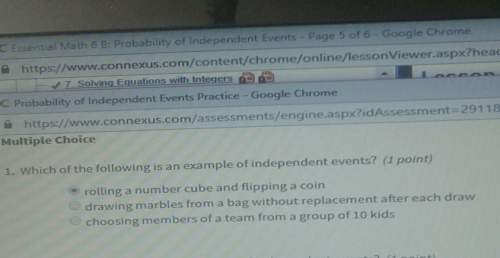
Mathematics, 24.03.2020 05:56 leannaadrian
Shaunta is developing a recursive formula to represent an arithmetic sequence in which 5 is added to each term to determine each successive term. Which formula could represent her sequence?
f(n + 1) = f(n) + 5
f(n + 1) = f(n + 5)
f(n + 1) = 5f(n)
f(n + 1) = f(5n)

Answers: 3


Another question on Mathematics

Mathematics, 21.06.2019 16:30
Which ordered pair (c,d) is a solution to the given system of linear equations- c+2d=13 -9c-4d=-15
Answers: 3


Mathematics, 21.06.2019 21:50
Which is the graph of this function 3 square root of x plus one if
Answers: 1

Mathematics, 21.06.2019 23:00
Each of the following data sets has a mean of x = 10. (i) 8 9 10 11 12 (ii) 7 9 10 11 13 (iii) 7 8 10 12 13 (a) without doing any computations, order the data sets according to increasing value of standard deviations. (i), (iii), (ii) (ii), (i), (iii) (iii), (i), (ii) (iii), (ii), (i) (i), (ii), (iii) (ii), (iii), (i) (b) why do you expect the difference in standard deviations between data sets (i) and (ii) to be greater than the difference in standard deviations between data sets (ii) and (iii)? hint: consider how much the data in the respective sets differ from the mean. the data change between data sets (i) and (ii) increased the squared difference îł(x - x)2 by more than data sets (ii) and (iii). the data change between data sets (ii) and (iii) increased the squared difference îł(x - x)2 by more than data sets (i) and (ii). the data change between data sets (i) and (ii) decreased the squared difference îł(x - x)2 by more than data sets (ii) and (iii). none of the above
Answers: 2
You know the right answer?
Shaunta is developing a recursive formula to represent an arithmetic sequence in which 5 is added to...
Questions


Mathematics, 13.11.2019 04:31

Mathematics, 13.11.2019 04:31


Physics, 13.11.2019 04:31


Biology, 13.11.2019 04:31





Mathematics, 13.11.2019 04:31


English, 13.11.2019 04:31


English, 13.11.2019 04:31








